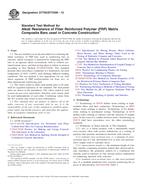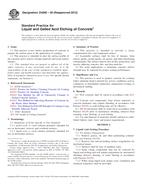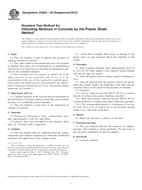We need your consent to use the individual data so that you can see information about your interests, among other things. Click "OK" to give your consent.
ASTM D7705/D7705M-12
Standard Test Method for Alkali Resistance of Fiber Reinforced Polymer (FRP) Matrix Composite Bars used in Concrete Construction
STANDARD published on 1.3.2012
The information about the standard:
Designation standards: ASTM D7705/D7705M-12
Note: WITHDRAWN
Publication date standards: 1.3.2012
SKU: NS-38985
The number of pages: 5
Approximate weight : 15 g (0.03 lbs)
Country: American technical standard
Category: Technical standards ASTM
The category - similar standards:
Annotation of standard text ASTM D7705/D7705M-12 :
Keywords:
alkali resistance, alkaline solution, fiber reinforced polymer (FRP), sustained loading, tensile capacity, tensile capacity retention, ICS Number Code 91.080.40 (Concrete structures)
Additional information
| Significance and Use | ||||||||||||||||||||||||||||
|
This test method is intended to determine alkaline resistance data for material specifications, research and development, quality assurance, and structural design and analysis. Depending on the procedure and test matrix, the primary test results are the mass change and tensile capacity retention of the test specimen, which are important factors to be considered in the use of FRP reinforcing bars. Procedures A and B are accelerated tests, substituting an alkaline aqueous environment for the presence of concrete porewater. Procedure C can be used to establish the accelerating effect of Procedure B. Procedure A is appropriate for rapid screening of FRP bars for alkali resistance. Procedure B is appropriate for characterizing the alkali resistance of FRP bars under sustained mechanical loading in a standard aqueous alkaline environment intended to represent the concrete porewater. Procedure C is appropriate for characterizing the alkali resistance of FRP bars under sustained mechanical loading in Portland cement concrete. |
||||||||||||||||||||||||||||
| 1. Scope | ||||||||||||||||||||||||||||
|
1.1 This test method covers the procedure for evaluating the alkali resistance of FRP bars used as reinforcing bars in concrete. Alkali resistance is measured by subjecting the FRP bars to an aqueous alkali environment, with or without sustained tensile stress, and then testing them to failure in tension according to Test Method D7205/D7205M. This standard presents three procedures conducted at a moderately elevated temperature of 60ºC (140ºF), each defining different loading conditions. The test method is also appropriate for use with linear segments of FRP reinforcements cut from two- or three-dimensional reinforcing grid. 1.2 The values stated in either inch-pound units or SI units shall be regarded separately as the standard. The inch-pound units are shown in the parenthesis. The values stated in each system are not exact equivalents; therefore each system shall be used independently of each other. Combining values from the two systems may result in non-conformance. 1.3 This standard does not purport to address all of the safety concerns, if any, associated with its use. It is the responsibility of the user of this standard to establish appropriate safety and health practices and determine the applicability of regulatory limitations prior to use. |
||||||||||||||||||||||||||||
| 2. Referenced Documents | ||||||||||||||||||||||||||||
|
Similar standards:
Historical
1.5.2012
Historical
1.5.2012
Historical
1.5.2012
Historical
1.5.2012
Historical
1.5.2012
Historical
1.5.2012
We recommend:
Technical standards updating
Do you want to make sure you use only the valid technical standards?
We can offer you a solution which will provide you a monthly overview concerning the updating of standards which you use.
Would you like to know more? Look at this page.



 ASTM D4258-05(2012)..
ASTM D4258-05(2012).. ASTM D4259-88(2012)..
ASTM D4259-88(2012).. ASTM D4260-05(2012)..
ASTM D4260-05(2012).. ASTM D4261-05(2012)..
ASTM D4261-05(2012).. ASTM D4262-05(2012)..
ASTM D4262-05(2012).. ASTM D4263-83(2012)..
ASTM D4263-83(2012)..
 Cookies
Cookies
